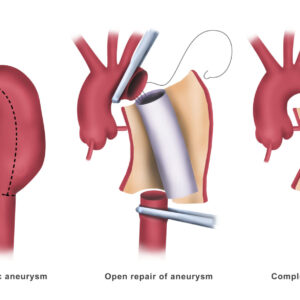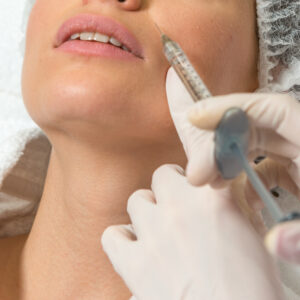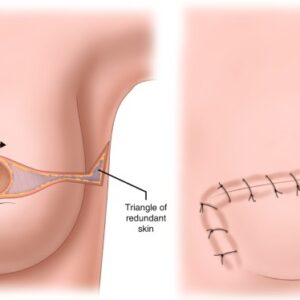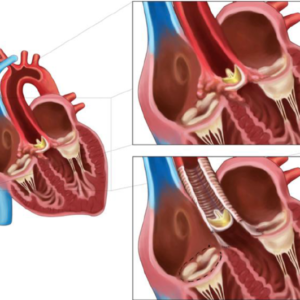Description
Familiarity with treatment
Excision is a surgical procedure commonly used for breast reduction in men with gynecomastia. Here is an explanation of the excision procedure based on the search results:
Procedure Overview: Excision involves the surgical removal of excess glandular tissue and, in some cases, excess skin to restore a flatter, firmer, and more masculine contour to the chest. It is typically performed under general anesthesia or intravenous sedation.
Incision Placement: The surgeon will make incisions in strategic locations to minimize visible scarring. The specific incision pattern will depend on the extent of gynecomastia and the desired outcome. Common incision patterns include:
Periareolar Incision: This incision is made around the edge of the areola (the dark skin surrounding the nipple). It allows for direct access to the glandular tissue and is suitable for mild to moderate cases of gynecomastia.
Inverted-T Incision: In more severe cases, an inverted-T incision may be used. This incision includes a periareolar incision and extends vertically from the bottom of the areola to the inframammary fold (crease beneath the breast). It allows for greater access to remove excess tissue and reshape the chest.
Glandular Tissue Removal: Once the incisions are made, the surgeon will carefully remove the excess glandular tissue. This may involve a combination of cutting and liposuction techniques, depending on the specific case. Liposuction may be used to remove excess fat in conjunction with excision.
Skin Excision: In cases where there is significant excess skin, the surgeon may also remove excess skin to achieve a more desirable chest contour. This step is more common in cases of severe gynecomastia or when there is significant skin laxity.
Closure and Recovery: After the excess tissue and skin have been removed, the incisions are closed with sutures. The surgeon may use absorbable sutures or traditional sutures that will need to be removed at a later date. Dressings or compression garments may be applied to support the healing process and minimize swelling.
Who is it suitable for?
Breast reduction surgery, specifically excision, is suitable for men with gynecomastia who have enlarged breasts due to excess glandular tissue. Here are some key points mentioned in the search results:
Gynecomastia: Gynecomastia is the condition of enlarged male breasts, which can be caused by hormonal imbalances, certain medications, genetics, obesity, or other factors.
Excess Glandular Tissue: Excision surgery is typically recommended when there is a significant amount of glandular tissue present. This technique involves the surgical removal of the excess glandular tissue to restore a flatter, firmer, and more masculine contour to the chest.
Combination of Liposuction and Excision: In some cases, a combination of liposuction and excision may be used to achieve the desired results. Liposuction is used to remove excess fat, while excision is performed to remove glandular tissue and reshape the chest.
Suitability: Male breast reduction surgery, including excision, is suitable for individuals who experience physical discomfort, self-consciousness, or emotional distress due to gynecomastia. It can help improve self-confidence and enhance the appearance of the chest.
Consultation with a Plastic Surgeon: It’s important to consult with a qualified plastic surgeon who specializes in gynecomastia surgery to determine the most appropriate surgical technique for your specific case. They will evaluate your condition, discuss your goals and expectations, and recommend the best approach for you.
Who is it not suitable for?
Based on the search results, breast reduction surgery, specifically excision, may not be suitable for the following individuals:
Those without Gynecomastia: Breast reduction surgery is primarily intended for individuals with gynecomastia, which is the enlargement of male breast tissue. If the breast enlargement is due to other factors, such as pseudogynecomastia (enlarged breast fat) or breast cancer, alternative treatments or evaluations may be necessary.
Those with Certain Medical Conditions: Some medical conditions may affect the suitability for breast reduction surgery. For example, individuals with impaired liver function or those taking estrogen-containing medications may not be considered good candidates for the procedure. It’s important to discuss your medical history with a qualified plastic surgeon to determine if breast reduction surgery is appropriate for you.
Those with Unrealistic Expectations: It’s crucial to have realistic expectations about the outcomes of breast reduction surgery. While the procedure can improve the appearance of the chest and enhance self-confidence, it’s important to understand that individual results may vary. It’s essential to have a thorough consultation with a plastic surgeon to discuss your goals and expectations.
Those with Certain Lifestyle Factors: Certain lifestyle factors may impact the suitability for breast reduction surgery. For example, individuals who smoke are at an increased risk of complications during the healing process. It’s advisable to quit smoking before undergoing any surgical procedure.
Advantages
Based on the search results, here are some advantages of breast reduction surgery, specifically excision, for men with gynecomastia:
Improved Self-Confidence: Gynecomastia can cause self-consciousness and impact self-esteem. Breast reduction surgery can help improve self-confidence by reducing the size of the breasts and restoring a more masculine chest contour 1.
Enhanced Body Image: Gynecomastia can lead to a disproportionate chest appearance, which may cause body image issues. Breast reduction surgery helps restore a more balanced physique, allowing men to feel more positive about their bodies 2.
Expanded Clothing Options: Men with gynecomastia often struggle to find clothing that fits well and flatters their figure. After breast reduction surgery, individuals can enjoy a broader range of clothing options and feel more comfortable in various styles 2.
Increased Comfort and Participation in Activities: Engaging in physical activities, such as sports or exercise, can be challenging for men with gynecomastia due to discomfort or self-consciousness. Breast reduction surgery eliminates these obstacles, enabling individuals to participate fully in the activities they enjoy 2.
Restored Masculine Appearance: Gynecomastia can affect the perception of masculinity. Breast reduction surgery helps restore a more masculine chest contour, allowing men to feel more comfortable and confident in their appearance 3.
Complications
Based on the search results, here are some advantages of breast reduction surgery, specifically excision, for men with gynecomastia:
Improved Self-Confidence: Gynecomastia can cause self-consciousness and impact self-esteem. Breast reduction surgery can help improve self-confidence by reducing the size of the breasts and restoring a more masculine chest contour 1.
Enhanced Body Image: Gynecomastia can lead to a disproportionate chest appearance, which may cause body image issues. Breast reduction surgery helps restore a more balanced physique, allowing men to feel more positive about their bodies 2.
Expanded Clothing Options: Men with gynecomastia often struggle to find clothing that fits well and flatters their figure. After breast reduction surgery, individuals can enjoy a broader range of clothing options and feel more comfortable in various styles 2.
Increased Comfort and Participation in Activities: Engaging in physical activities, such as sports or exercise, can be challenging for men with gynecomastia due to discomfort or self-consciousness. Breast reduction surgery eliminates these obstacles, enabling individuals to participate fully in the activities they enjoy 2.
Restored Masculine Appearance: Gynecomastia can affect the perception of masculinity. Breast reduction surgery helps restore a more masculine chest contour, allowing men to feel more comfortable and confident in their appearance 3.
preoperative care
The preoperative care for breast reduction surgery in men with gynecomastia, specifically excision, may involve the following considerations:
Consultation with a Plastic Surgeon: The first step is to schedule a consultation with a qualified plastic surgeon who specializes in gynecomastia surgery. During this consultation, the surgeon will evaluate your condition, discuss your goals and expectations, and determine if you are a suitable candidate for breast reduction surgery.
Medical Evaluation: Before the surgery, you may undergo a medical evaluation to assess your overall health and ensure that you are fit for the procedure. This evaluation may include a physical examination, blood tests, and possibly other diagnostic tests as deemed necessary by your surgeon.
Discussion of Expectations: It’s important to have a thorough discussion with your surgeon about your expectations for the surgery. This includes discussing the desired size and shape of your chest, as well as any concerns or questions you may have.
Review of Risks and Benefits: Your surgeon will explain the potential risks and complications associated with breast reduction surgery. It’s important to understand these risks and make an informed decision about proceeding with the surgery.
Preparation Instructions: Your surgeon will provide you with specific instructions to prepare for the surgery. This may include guidelines on medications to avoid before the procedure, fasting instructions, and any necessary lifestyle modifications.
Smoking and Medication Cessation: If you smoke, your surgeon may advise you to quit smoking before the surgery, as smoking can increase the risk of complications and impair the healing process. Additionally, you may need to discontinue certain medications or supplements that can interfere with the surgery or the healing process.
Arranging for Support: It’s helpful to arrange for someone to accompany you on the day of the surgery and to assist you during the initial recovery period.
Postoperative care
The postoperative care for breast reduction surgery in men with gynecomastia, specifically excision, may involve the following considerations:
Recovery Period: After the surgery, you will need to allow yourself time to recover. The duration of the recovery period may vary depending on the extent of the surgery and individual healing capabilities. Your surgeon will provide specific instructions regarding the recovery timeline.
Pain Management: You may experience some discomfort or pain after the surgery. Your surgeon may prescribe pain medication to help manage any postoperative pain. It’s important to follow the prescribed dosage and instructions for pain medication.
Compression Garments: Your surgeon may recommend wearing a compression garment or a specialized postoperative vest to support the healing process and minimize swelling. These garments help reduce fluid buildup and provide support to the surgical area.
Wound Care: Proper wound care is essential for optimal healing. Your surgeon will provide instructions on how to care for the incision sites, including when and how to clean them, as well as any necessary dressing changes.
Activity Restrictions: It’s important to follow your surgeon’s instructions regarding activity restrictions during the recovery period. You may need to avoid strenuous activities, heavy lifting, or exercises that put strain on the chest area for a certain period of time.
Follow-up Appointments: You will have follow-up appointments with your surgeon to monitor your healing progress. These appointments allow your surgeon to assess the surgical site, remove any sutures if necessary, and address any concerns or questions you may have.
Scarring: Scarring is a normal part of the healing process. Your surgeon will provide guidance on scar management techniques, such as applying scar creams or silicone sheets, to help minimize the appearance of scars over time.









Reviews
There are no reviews yet.